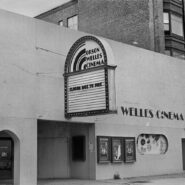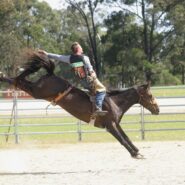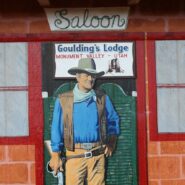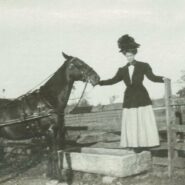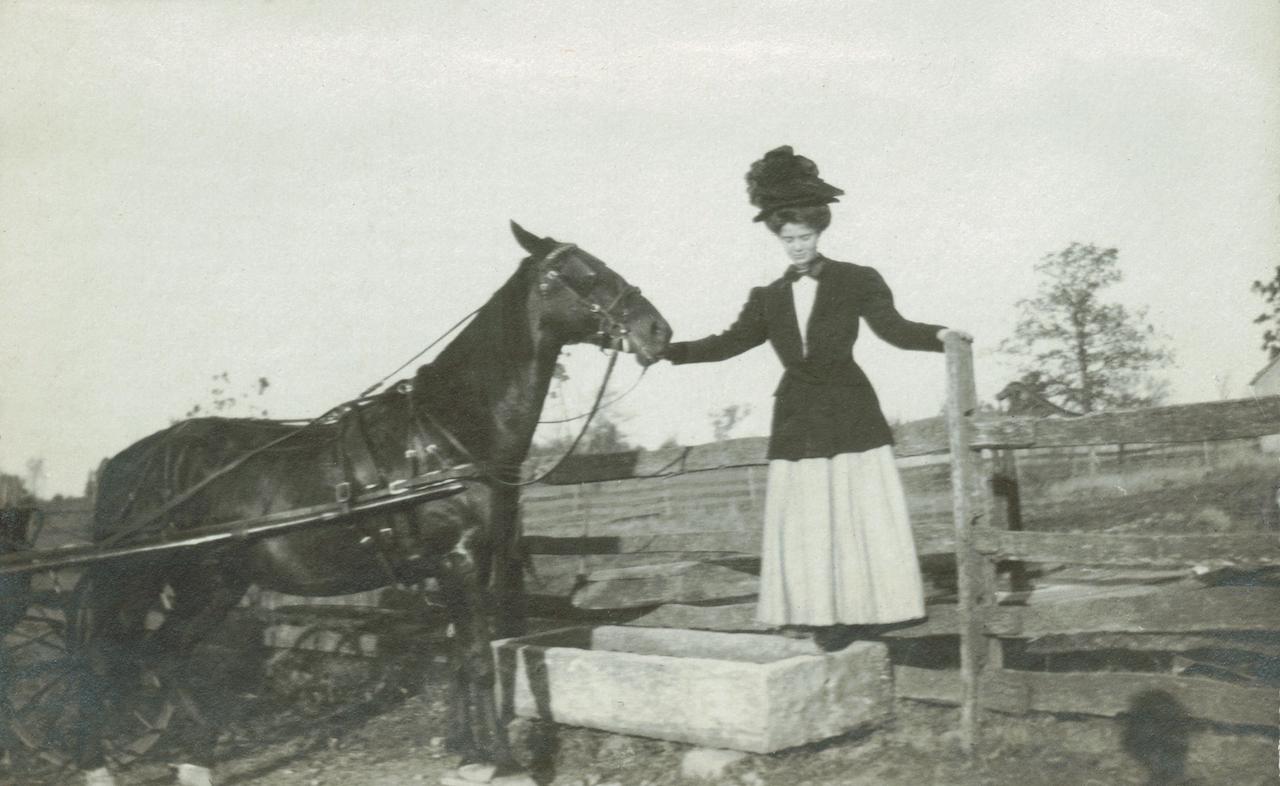
When most people think of western films, they usually picture a cowboy such as John Wayne or Clint Eastwood. Women tend to be afterthoughts or a part of the scenery, rather than actual members of the story. While it is true that in many western films from the 1910s to the 1930s, women were more often used as tools to further the plot, create conflict between the hero and villain, and give the hero further opportunity to show his strength and bravery. However, with World War II, the way women were represented in film changed as it mimicked the real-life changes in the world. WWII allowed women more freedoms, as they had to take on previously masculine roles and duties. Westerns became the perfect avenue for this as historically women played a major part in “settling the West,” for example thousands of women journeyed West under the Homestead Act. Here we have provided a list of five influential western films that presented strong cowgirl characters and broke away from previous molds.
1. Ramrod (1947)
In Ramrod, Veronica Lake plays a rancher’s daughter, Connie Dickason, who is trying to fight against the town bully and main villain, Frank Ivey. She originally hopes that her fiancé Walt Shipley will stand up to Ivey, but after he bows out, she decides to forgo pinning her hopes on a man and tries to take down Ivey’s regime herself. She and her ramrod, or foreman, Dave Nash (Joel McCrea), intend on doing everything by the law, but after Ivey attacks and wounds a friend, Connie takes matters into her own hands.
This is a revolutionary role, as it presents a woman who can handle the domestic roles, like cleaning and cooking, along with knowing how to ride a horse and work her land. At first Connie tries to accomplish her goals through others, such as using her fiancé. However, after he deserts her, Connie dons the white hat and decides to go after Ivey herself.
“Dave: What did you expect him to do? Connie Dickason: Marry me and stay and fight! Not stick a note under my door and run…wasn’t strong enough was he? Dave: [Shakes head] No. Connie Dickason: Well I am. Strong enough to beat both dad and Ivey at their own business. They broke Walt and I’m going to fight back! I’ll make Circle 66 an outfit they’ll respect.”[1]
In fact Connie’s character is very similar to the male heroes in Destry Rides Again (1939) and The Man Who Shot Liberty Valence (1962). In both of these films the main characters make a decision to not use guns, but rather words when dealing with problems. However, both main characters reach a point where they realize that the only way to handle the situation is on the enemy’s terms, such as Connie does. This makes Connie a cowboy vigilante who is not afraid to break the law in order to achieve justice.
2. Red River (1948)
Red River is a fictionalized account of the historic Chisholm Trail. It stars John Wayne as Tom Dunson, and Montgomery Clift as Matt Garth. Dunson starts a cattle ranch in Texas and adopts the only survivor of a caravan attack, Garth, raising him as his own. Fourteen years pass and Dunson has decided to drive the cattle north to Missouri, but on the trail things do not turn out quite as he planned. Dunson becomes a tyrant, the crew mutinies, and Garth takes over. Later, Garth and his team encounter Native Americans attacking a troop of wagoners and step in to help them. There he meets the cardshark cowgirl, Tess Millay (Joanne Dru) and falls in love. He leaves Tess behind, but she and Dunson trek after Garth. Garth successfully brings the cattle to Kansas, resolves his issues with Dunson, wins the girl, and has his name added to the brand and ranch.
Tess Millay’s strong cowgirl character is completely different from the novel it’s based on. The director, Howard Hawks, chose to shift the Millay character from the original depiction of a gold-digger and prostitute to that of an independent, brave, cowgirl. When we are first introduced to Millay she is in the frontlines of battle. In fact, she is the only woman that is out with the men, doing her best to defend herself and the rest of the wagoners. She continues to show her strength and bravery when an enemy arrow pierces her arm. Instead of crying out or showing any emotion, she continues with her tasks, never stopping to consider the pain. Tess is also the only character in the film who does not tremble at the sound or presence of Dunson. Even the hero, Garth, who mutinied against Dunson, is completely terrified of him. Tess is one of the few people who staunchly refuses to comply with any of his demands.
“Tom Dunson: Stand up and turn around. Tess Millay: Don’t tell me what to do Mr. Dunson! Tom Dunson: [Shocked] Alright.”[2]
In fact, Tess does what no other man was able to do, physically take action against Dunson. At the end of the film, when Dunson attacks Garth, she intercedes in the fight, nicking him with a bullet to end Dunson’s tyranny, something every man wanted to do, but failed to accomplish.
3. Montana (1950)
Montana stars Errol Flynn as Morgan Lane, a sheepherder who has returned to Montana in hopes of achieving his father’s dream of sheep farming. However, he discovers that the area is controlled by three sattle barons: Maria Singleton played by Alexis Smith; Rodney Ackroyd, and George Forsythe. Lane tries to win over Maria and con some land out of her, but his plans fail. Lane then turns to small ranchers, trying to prove that sheep and cattle should be raised together. His actions create a war, as Maria and Ackroyd’s men face off against Lane and his supporters.
Maria is a true cowgirl. She belongs in the West and to the land. After the men in her family died, she took command of the land and continued to run it well. She is proud to be a rancher and is proud of her land, striving to protect it and see it prosper.
“Maria Singleton: This is cattle country, cattle built our homes and gave us a living ever since our fathers settled here. No sheep was the cattleman’s law…well it still is the law and we’ll back it up with every man and gun in the Singleton outfit! Where’s your loyalty? To your friends, your families, your fathers, to the tradition of the range? If those graves that mark the deadline mean nothing to you, well they do to me! Our fathers died in a war to keep Montana cattle land! Well now it’s war again, and whatever it costs in lives and property you can blame it on one man, Morgan Lane.” [3]
Maria’s character also exemplifies a marriage between masculinity and femininity that was not common in films at the time. Maria shows that she can be a tough, gun-toting, masculine, career woman, but at the same time be feminine. This duality shows stories of the West do not have to follow the formula of an “untamed wilderness” that gave way to “civilization.” That the West can be “wild” and free to roam, while at the same time be built upon and protected by legalities, or “civilized.”
4. Rawhide (1951)
The film Rawhide (not the television show) is a thriller-suspense western starring Tyrone Power as Tom Owens, the son of a stagecoach tycoon, living out West at a stopover station, Rawhide. When four prisoners escape from the nearby jail, singer turned cowgirl, Vinnie Holt (played by Susan Hayward) and her niece Callie are forced to stay the night. That night, Rawhide is attacked by the outlaws, as they intend on robbing an incoming stagecoach full of gold. This soon turns into a game of cat and mouse as Owens and Vinnie try to figure a way out of the situation without revealing their plans to the outlaws.
Throughout the film, Vinnie is equal to her male counterpart. She always performs the same duties as Owens. She even assists Owens in digging a hole through the wall to escape their captors. The film also reverses the damsel in distress cliché that one would expect. Throughout the movie, Vinnie is constantly harassed and attacked by the convicts, but never saved by anyone. Instead, Vinnie uses her strength, cunning, and resoluteness needed to survive living in the West. At the end of the film, one of the convicts disarms Owens and forces him to lay down on the ground. Before he has a chance to shoot him, Vinnie steps in and kills him, making this a film in which a woman uses a gun to resolve the situation, while the man lies helpless on the ground.
5. Calamity Jane (1953)
Calamity Jane (1953) is a musical film loosely based on the historic cowgirl and sharpshooter. Doris Day is Calamity Jane, a sharpshooter who wears men’s clothing, spends time in the saloon, gambles, and saves damsels in distress. In a series of comedic events she is given the task of bringing actress Adelaid Adams from Chicago, Illinois to Deadwood, South Dakota. When Calamity mistakes assistant Katie Brown for Adelaid, Katie goes along with the deception and journeys to Deadwood. There Katie’s real identity is found out, but she quickly becomes the toast of the town. She and Calamity room together, and Katie tries to change Calamity’s ways, attempting to “feminize” her. Katie has also has attracted the attentions of “Wild Bill” Hickok and Lt. Daniel Martin, the latter being the man Calamity is in love with. When Calamity discovers the attraction between Martin and Katie, their friendship is destroyed by her jealousy. In the end all is resolved, as Bill and Calamity realize their love for each other, and Calamity and Katie’s friendship is restored.
Even though this film is a comedic musical, it still manages to present a strong image of a cowgirl, doing far better than the contemporary Annie Get Your Gun (1950). The whole focus in Annie Get Your Gun is how to catch a man, with Annie Oakley even going as far as losing a shooting match to protect her man’s pride and win his heart. While Calamity does silly things, she nevertheless is presented as a caring, intelligent, strong woman. A majority of the film focuses on the love triangle between Katie, Jane, Bill, and Lt. Martin; Calamity still remains an independent, strong-willed character who refrains from changing herself for anyone. She does start wearing dresses to appease Katie, but by the end of the film she is back in the buckskin, as she decides to be herself, and not what others try to conform her to.
